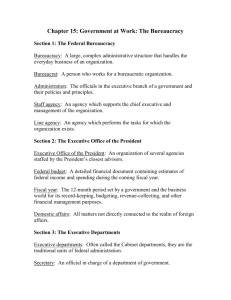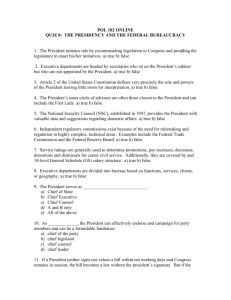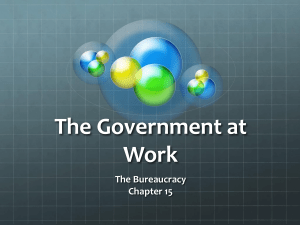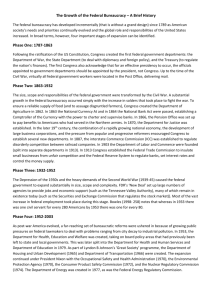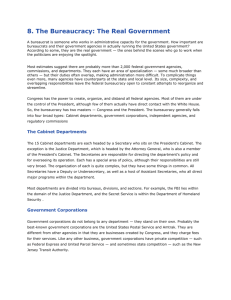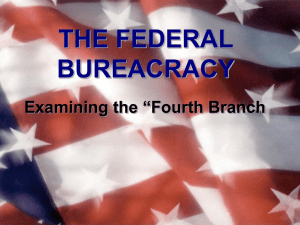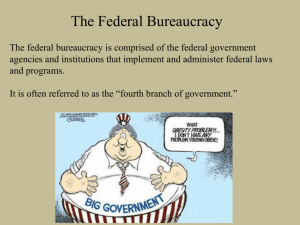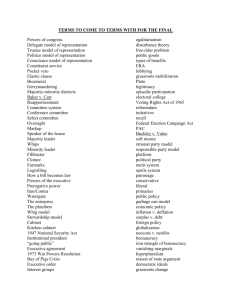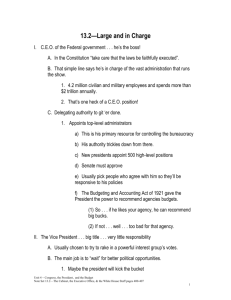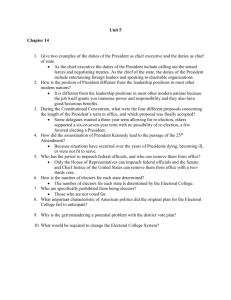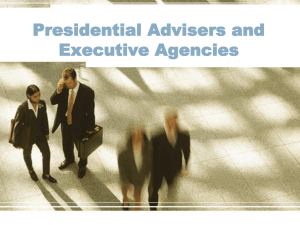Unit 4 * The Executive Branch
advertisement
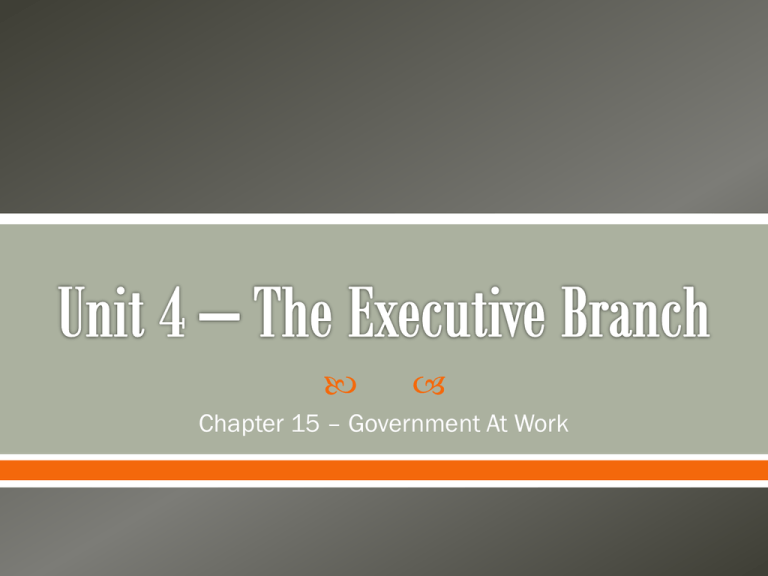
Chapter 15 – Government At Work I. What is a Bureaucracy? An efficient and effective way to organize people to do work a. Three Features of Bureaucracy i. Hierarchical Authority – built like a pyramid, chain of command running from top to bottom ii.Job Specialization – Each bureaucrat (person who works for the organization) has certain defined duties and responsibilities iii.Formalized Rules – work according to a set of regulations and procedures b. The Benefits of Bureaucracy – effective, can speed action by reducing conflict, bureaucrats hold appointive offices so effectiveness is subject to the effectiveness of those who appoint The term “red tape” comes from red ribbon used by British bureaucrats to hold their paperwork together. I. Major Elements of the Federal Bureaucracy a. The federal bureaucracy is all of the agencies, people, and procedures through which the Federal government operates. It is the means by which the government makes and administers public policy. b. The Framer’s intended for administrative agencies to be created. Without an administration – the government’s many administrators and agencies – even the best policies would amount to just so many words. I. The Name Game a. Titles vary greatly i. Department typically denotes agencies of cabinet rank. An agency is any governmental body. A commission is usually an agency charged with the regulation of business activities. A corporation or authority is often given to an agency that conducts business-like activities. A bureau is the name given to the major element in a department. I. Staff and Line Agencies a. Staff agencies serve in a support capacity. Line agencies perform the tasks for which an organization exists. I. The Executive Office of the President a. Every officer, employee, and agency in the executive branch of the Federal Government is legally subordinate to the President. They all exist to help the President in the exercise of the executive power. The Executive Office of the President (several agencies staffed by the President’s Advisors) is the President’s right arm. I. II. The White House Office - The White House houses the President’s key personal and political staff. The National Security Council a. The President’s major foreign affairs moves are taken in close consultation with the National Security Council. The President chairs this council. Also contains a small staff of foreign and military policy experts. I. Office of Management and Budget a. The Office of Management and Budget is the largest, and after the White House, the most influential unit in the Executive Office. Its major task is the preparation of the federal budget, which the President must submit to Congress each year. b. The federal budget is a very detailed estimate of receipts and expenditures, an anticipation of the federal income and outgo during the next fiscal year (the 12 month period used by government and business for record keeping, budgeting, and other management) c. The budget is a closely detailed work plan for the conduct of the government. I. Other EOP Agencies a. Office of National Drug Control Policy i. Has two major responsibilities – prepares an annual national drug control strategy which the President sends to Congress and coordinating the ongoing efforts of the more than 50 federal agencies that participate in the continuing war on drugs b. Council of Economic Affairs i. Is composed of three of the country’s leading economists and is the chief source of information on the state of the nation’s economy i. The Office of Policy Development advises the President on all matters relating to the nation’s domestic affairs – all matters not directly connected to the realm of foreign affairs ii. The Council of Environmental Quality aids the President in environmental policy. iii.The Office of the United States Trade Representative advises the President in all matters of foreign trader. iv.The Office of Science and Technology Policy is the President’s major advisor in all scientific, engineering, and other technology matters The Executive Departments – much of the work of the Federal Government is done by the 15 executive departments I. Executive Departments a. Chief Officers and Staff Each department is headed by a secretary, except for the Department of Justice whose work is directed by the attorney general. Each department head is the primary link between presidential policy and his/her department. Each strives to promote or protect his/her department with the White House (and Congress and its committees and the media) b. Subunits i. Each department up made up of a number of subunits, both staff and line. Each of these subunits, or agencies, is usually further divided into smaller working units. Most of these agencies are structured geographically. c. The Departments Today i. Vary greatly; the Department of the State is the oldest and most prestigious. The Department of Health and Human Services has the largest budget. I. The Cabinet a. The Cabinet is an informal advisory body brought together by the President to serve his needs. At its first session, Congress established the 4 top-level executive posts – secretary of state, secretary of treasury, secretary of war, and the attorney general. The heads of the now 15 executive departments form the Cabinet. b. Choosing Cabinet Members i. The President appoints the head of each of the 15 executive departments. Each of these is subject to confirmation by the Senate, but rejection is rare. ii. Many factors influence this choice – party, helping the President win office, professional qualifications and practical experience, geography, interest groups, gender, race, management ability and experience, etc. c. Women and Minorities i. Women and minorities have only gradually become represented in the Cabinet. d. The Cabinet’s Role i. Have two major jobs – each is the administrative head of one of the executive branches & advisors to the President ii.Most Presidents give great weight to the Cabinet and to its advice. Many have held regular Cabinet meetings. Independent Agencies – additional agencies created by Congress located outside the Cabinet departments I. Why Independent Agencies? a. Some have been set up outside of the regular departmental structure simply because they do not fit well into any department. Some have been given independent status to protect them from the influence of partisan/political pressure. Some were just created independently. b. There are three main groups – the independent executive agencies, the independent regulatory commissions, and the government corporations. I. The Independent Executive Agencies a. Most independent agencies; some are large, with thousands of employees with large budgets Examples – The Civil Rights Commission, The Peace Corps, The Federal Election Commission, and the National Transportation Safety Board I. Independent Regulatory Commissions a. Stand out because they are largely beyond the reach of presidential direction and control b. Independence comes mainly from the way they have been structured by Congress. Each is headed by a board or commission made up of five to seven members appointed by the President with the Senate’s approval. Several of these officers belong to the party out of power. Appointment terms of members are staggered and these members may be removed by the President only for reasons specified by Congress. c. Congress has given them the power to administer the programs for which they are created. d. These regulatory bodies have powers of all three basic – executive, legislative, and judicial. e. Rethinking Regulation – several authorities have urged that at least the administrative functions of these commissions be given to executive department agencies. They are concerned that some of the independent regulatory commissions may have been captured by special interest groups. I. The Government Corporations a. Corporations within the executive branch subject to the President’s direction and control, set up by Congress to carry out business-like activities b. 50 of these – Postal Service, etc. c. Government v. Private Corporations i. Government corporations are typically set up like a corporation in the private sector. Differences include: Congress decided their purpose and functions; they are financed by public funds which are appropriated by Congress d. Degrees of Independence i. Varies greatly; some are attached to an executive department but some have a lot of independence The Civil Service – composed of those civilian employees who perform the administrative work of government. More than 2.7 million people work for the Federal government I. Development of the Civil Service a. The Spoils System i. Andrew Jackson is known as the “father” of the Spoils System – the practice of giving offices and the other favors of government to political supporters and their friends. This is also called Patronage ii. Jackson defended this policy – the duties are simple, any normal intelligent person can fill an office; there should be a “rotation of office” so that many people have the privilege; long service can lead to tyranny and inefficiency; people are entitled to have the party that they have placed in power placed in power control of all offices of government a. The Movement to Reform i. In 1881, President James Garfield was shot by a man who he had rejected to a high diplomatic post for being mentally unstable. b. The Pendleton Act i. Laid the foundation of the present federal civil service system ii.It was intended to make merit the basis for hiring, promotion, and other personnel actions in the federal work force iii.Two categories – classified (to be based on merit) and unclassified I. The Civil Service Today – today, most federal employees are hired through a competitive process a. The Office of Personnel Management – the Federal government’s personnel agency. It advertises for employees, examines those who apply, and keeps registers (lists of applicants) b. Pay and Benefits – Although women and minorities are well represented among agencies, they tend to be concentrated in lower-level positions. I. Political Activities a. Hatch Act of 1939 – the law allows federal workers to vote in elections but forbids them to take part in partisan political activities b. Federal Employees Political Activities Act of 1993 – relaxed these restrictions; today, a federal employee has the right to vote, help register new voters, contribute money to candidates and parties, participate in campaigns, and hold office in a political party
